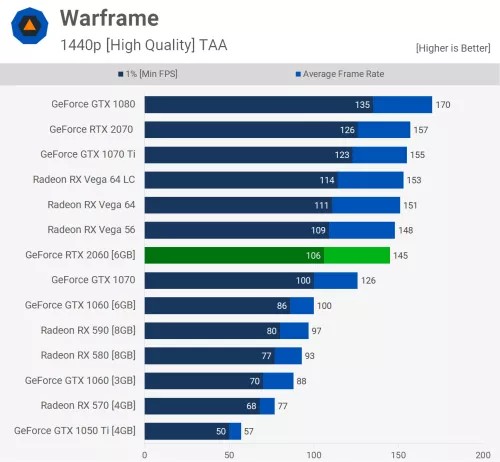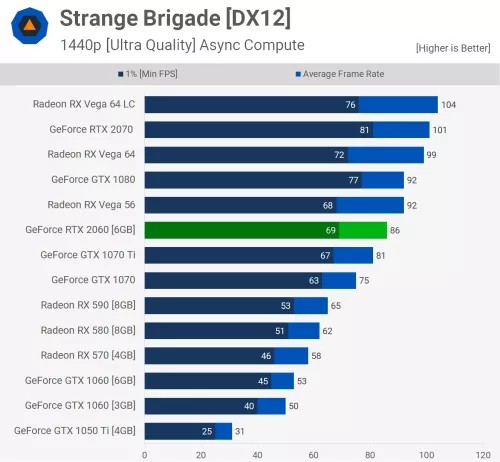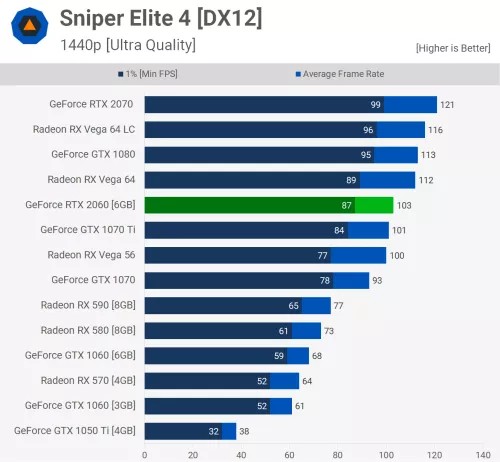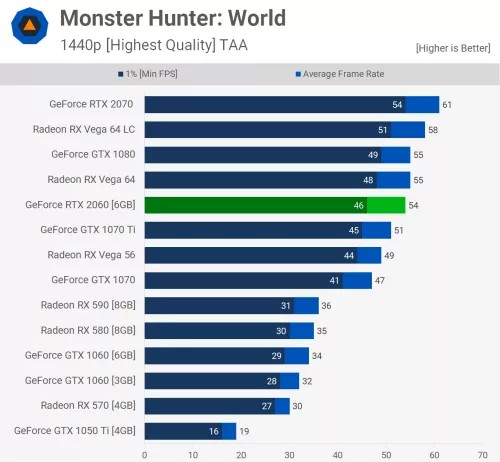The RTX 2060 represents a sweet spot in the graphics card market, offering a compelling blend of performance and price. This analysis from COMPARE.EDU.VN explores what the RTX 2060 is comparable to in terms of performance and features, providing a comprehensive understanding for gamers and enthusiasts. Dive in and discover the graphics card alternatives and comparisons that will inform your next upgrade.
1. RTX 2060: A Mid-Range Marvel
The Nvidia GeForce RTX 2060, released in early 2019, was designed to bring ray tracing and DLSS (Deep Learning Super Sampling) to a more accessible price point. It aimed to deliver a significant performance uplift over its predecessors while introducing new technologies. Let’s examine the core specifications:
- Architecture: Turing
- CUDA Cores: 1920
- Boost Clock: Around 1680 MHz (varies by model)
- Memory: 6GB GDDR6
- Memory Bus: 192-bit
- Memory Bandwidth: 336 GB/s
- RT Cores: 30
- Tensor Cores: 240
- TDP (Thermal Design Power): 160W
This configuration allowed the RTX 2060 to handle 1080p and 1440p gaming with reasonable settings and frame rates. But what other GPUs offer similar performance?
2. Direct Competitors and Alternatives
To understand where the RTX 2060 stands, let’s compare it to some of its direct competitors and alternatives from both Nvidia and AMD.
2.1. Nvidia GeForce GTX 1070 Ti
The GTX 1070 Ti was a high-end card from the previous generation (Pascal architecture) that offered excellent performance. Here’s how it stacks up against the RTX 2060:
| Feature | RTX 2060 | GTX 1070 Ti |
|---|---|---|
| Architecture | Turing | Pascal |
| CUDA Cores | 1920 | 2432 |
| Boost Clock | ~1680 MHz | ~1683 MHz |
| Memory | 6GB GDDR6 | 8GB GDDR5 |
| Memory Bus | 192-bit | 256-bit |
| Memory Bandwidth | 336 GB/s | 256 GB/s |
| RT Cores | 30 | N/A |
| Tensor Cores | 240 | N/A |
| TDP | 160W | 180W |




In terms of raw performance, the RTX 2060 generally matches or slightly outperforms the GTX 1070 Ti in most modern games. The RTX 2060 also benefits from newer technologies like ray tracing and DLSS, which the GTX 1070 Ti lacks. The GTX 1070 Ti has more VRAM, which can benefit titles that demand it.
2.2. AMD Radeon RX Vega 56
The RX Vega 56 was AMD’s offering in the same performance tier. Let’s see how it compares:
| Feature | RTX 2060 | RX Vega 56 |
|---|---|---|
| Architecture | Turing | Vega |
| Stream Processors | 1920 (CUDA) | 3584 |
| Boost Clock | ~1680 MHz | ~1470 MHz |
| Memory | 6GB GDDR6 | 8GB HBM2 |
| Memory Bus | 192-bit | 2048-bit |
| Memory Bandwidth | 336 GB/s | 410 GB/s |
| RT Cores | 30 | N/A |
| Tensor Cores | 240 | N/A |
| TDP | 160W | 210W |
The RX Vega 56 often trades blows with the RTX 2060, with performance varying depending on the game. The Vega 56 typically consumes more power and generates more heat. The RTX 2060 offers ray tracing and DLSS. The Vega 56 also has more memory bandwidth and larger memory capacity.
2.3. Nvidia GeForce RTX 2070
Stepping up the ladder, the RTX 2070 is a higher-tier card within the same generation. Comparing it helps to contextualize the RTX 2060’s position:
| Feature | RTX 2060 | RTX 2070 |
|---|---|---|
| Architecture | Turing | Turing |
| CUDA Cores | 1920 | 2304 |
| Boost Clock | ~1680 MHz | ~1710 MHz |
| Memory | 6GB GDDR6 | 8GB GDDR6 |
| Memory Bus | 192-bit | 256-bit |
| Memory Bandwidth | 336 GB/s | 448 GB/s |
| RT Cores | 30 | 36 |
| Tensor Cores | 240 | 288 |
| TDP | 160W | 175W-185W |
The RTX 2070 offers a noticeable performance increase over the RTX 2060, primarily due to its higher CUDA core count and wider memory bus. This translates to higher frame rates, especially at 1440p and beyond. In some games, the RTX 2060 can be surprisingly close to the RTX 2070, making it a compelling value proposition.
2.4. AMD Radeon RX 5700
The RX 5700 is another AMD card that competes with the RTX 2060. It’s based on the Navi architecture and offers competitive performance:
| Feature | RTX 2060 | RX 5700 |
|---|---|---|
| Architecture | Turing | Navi |
| Stream Processors | 1920 (CUDA) | 2304 |
| Boost Clock | ~1680 MHz | ~1725 MHz |
| Memory | 6GB GDDR6 | 8GB GDDR6 |
| Memory Bus | 192-bit | 256-bit |
| Memory Bandwidth | 336 GB/s | 448 GB/s |
| RT Cores | 30 | N/A |
| Tensor Cores | 240 | N/A |
| TDP | 160W | 180W |
The RX 5700 often trades blows with the RTX 2060, sometimes outperforming it in certain titles. It lacks the ray tracing and DLSS capabilities of the RTX 2060.
3. Performance Benchmarks in Games
Let’s look at some specific game benchmarks to illustrate the RTX 2060’s performance relative to other cards.
3.1. Shadow of the Tomb Raider
In Shadow of the Tomb Raider, the RTX 2060 performs admirably, often matching the GTX 1080 and Vega 64.
At high settings, the RTX 2060 achieves an average of 63 fps, making it just 5% slower than the RTX 2070.
3.2. Battlefield V
The RTX 2060 excels in Battlefield V.
It closely trails the RTX 2070 by only 4% and outperforms the GTX 1070 Ti and Vega 56.
3.3. Monster Hunter: World
The RTX 2060 handles Monster Hunter: World well at 1440p.
It averages 54 fps with the highest quality preset, performing similarly to Vega 64 and the GTX 1080. It’s only 11% slower than the RTX 2070.
3.4. Just Cause 4
In Just Cause 4, the RTX 2060 averages 59 fps.
It’s just a few frames slower than the GTX 1080 and Vega 64 and 11% slower than the RTX 2070 and Vega 64 Liquid.
4. Features and Technologies
Beyond raw performance, the RTX 2060 brings several key features to the table:
4.1. Ray Tracing
One of the major selling points of the RTX 2060 is its support for real-time ray tracing. While it’s not as powerful as higher-end RTX cards in this regard, it can still deliver impressive visual effects in games that support the technology. Ray tracing simulates the physical behavior of light, creating more realistic reflections, shadows, and lighting.
4.2. DLSS (Deep Learning Super Sampling)
DLSS is another Nvidia-exclusive technology that uses AI to upscale lower-resolution images to a higher resolution, improving performance without sacrificing visual quality. DLSS can provide a significant performance boost in supported games, making it a valuable tool for the RTX 2060.
4.3. Adaptive Shading
Adaptive shading is a technique that dynamically adjusts the shading rate in different areas of the screen, reducing the workload on the GPU and improving performance. This can be especially useful in games with complex scenes and lighting.
4.4. Nvidia Highlights and Ansel
Nvidia Highlights automatically captures key moments in your games, such as kills and victories, allowing you to easily share them with friends. Nvidia Ansel allows you to take professional-grade screenshots in supported games, with advanced controls for camera positioning, filters, and more.
5. Cost Per Frame Analysis
Analyzing the cost per frame can provide insights into the value proposition of the RTX 2060 compared to other cards.
5.1. Original MSRP
The RTX 2060 launched with an MSRP of around $350.
5.2. Cost Per Frame vs. Alternatives
Considering its original price and performance, the RTX 2060 offered an excellent cost-per-frame ratio. It often outperformed or matched more expensive cards from the previous generation, making it a popular choice for budget-conscious gamers.
5.3. Market Dynamics
However, market dynamics, such as supply chain issues and cryptocurrency mining booms, can significantly impact the price and availability of graphics cards. It’s essential to consider current market prices when evaluating the cost per frame.
6. Real-World Scenarios and Use Cases
The RTX 2060 shines in various real-world scenarios.
6.1. 1080p Gaming
The RTX 2060 is an excellent choice for 1080p gaming, delivering high frame rates and smooth gameplay in most titles. It can handle demanding games at high or ultra settings, providing a visually immersive experience.
6.2. 1440p Gaming
The RTX 2060 can also handle 1440p gaming, although you may need to adjust settings in some games to maintain acceptable frame rates. It strikes a good balance between visual quality and performance at this resolution.
6.3. VR Gaming
The RTX 2060 is VR-ready and can provide a decent VR gaming experience. While it may not be able to handle the most demanding VR titles at the highest settings, it can still deliver smooth and immersive gameplay.
6.4. Content Creation
The RTX 2060 can also be used for content creation tasks such as video editing, graphic design, and 3D rendering. Its CUDA cores and Tensor cores can accelerate these workloads, making it a suitable option for hobbyists and professionals on a budget.
7. Detailed Performance Comparison
To provide a comprehensive understanding, let’s break down the RTX 2060’s performance in specific scenarios compared to its alternatives:
7.1. Gaming at 1080p
- RTX 2060 vs. GTX 1070 Ti: The RTX 2060 generally matches or slightly outperforms the GTX 1070 Ti in most modern titles, offering similar or better frame rates with the added benefits of ray tracing and DLSS.
- RTX 2060 vs. RX Vega 56: The RTX 2060 and RX Vega 56 trade blows depending on the game, with the RTX 2060 having an edge in titles that support ray tracing and DLSS.
- RTX 2060 vs. RTX 2070: The RTX 2070 offers a noticeable performance uplift, delivering higher frame rates in most games. However, the RTX 2060 provides excellent value for its price point.
- RTX 2060 vs. RX 5700: The RX 5700 often matches or outperforms the RTX 2060 in raw gaming performance, but lacks ray tracing and DLSS support.
7.2. Gaming at 1440p
- RTX 2060 vs. GTX 1070 Ti: At 1440p, the RTX 2060 continues to perform on par with the GTX 1070 Ti, offering a similar gaming experience with the advantage of newer features.
- RTX 2060 vs. RX Vega 56: The RX Vega 56 may outperform the RTX 2060 in some titles at 1440p, but the RTX 2060’s ray tracing and DLSS support can provide a better overall experience in supported games.
- RTX 2060 vs. RTX 2070: The RTX 2070 pulls ahead at 1440p, delivering significantly higher frame rates and a smoother gaming experience.
- RTX 2060 vs. RX 5700: The RX 5700 often matches or outperforms the RTX 2060 at 1440p, making it a competitive option for gamers looking for raw performance without ray tracing.
7.3. Ray Tracing Performance
- RTX 2060 vs. RTX 2070: The RTX 2070 provides better ray tracing performance due to its higher RT core count. However, the RTX 2060 can still deliver playable frame rates with ray tracing enabled, especially with DLSS.
7.4. DLSS Performance
- RTX 2060 vs. Alternatives: DLSS provides a significant performance boost in supported games, allowing the RTX 2060 to achieve higher frame rates and better visual quality than its competitors without DLSS support.
8. User Reviews and Feedback
Analyzing user reviews and feedback can provide valuable insights into the real-world performance and reliability of the RTX 2060.
8.1. Common Praises
- Excellent 1080p performance
- Good value for the price
- Ray tracing and DLSS support
- Quiet and efficient cooling
8.2. Common Criticisms
- Limited VRAM (6GB)
- Ray tracing performance not as strong as higher-end RTX cards
8.3. Overall Satisfaction
Overall, the RTX 2060 receives positive reviews from users who appreciate its balance of performance, features, and price. It’s often recommended as a great option for gamers on a budget who want to experience ray tracing and DLSS.
9. Current Market Availability and Pricing
The market availability and pricing of the RTX 2060 can vary depending on current market conditions.
9.1. Factors Affecting Price
- Supply and demand
- Cryptocurrency mining trends
- Global economic conditions
9.2. Where to Buy
The RTX 2060 can be purchased from various online and retail stores.
9.3. Price Monitoring
It’s essential to monitor prices and compare different retailers to find the best deal on the RTX 2060.
10. Future-Proofing Considerations
When choosing a graphics card, it’s important to consider its future-proofing capabilities.
10.1. VRAM Limitations
The RTX 2060’s 6GB of VRAM may become a limiting factor in future games with higher texture resolutions and more complex scenes.
10.2. Ray Tracing Adoption
As more games adopt ray tracing, the RTX 2060’s ray tracing performance may become less competitive compared to newer cards with more powerful RT cores.
10.3. DLSS Support
DLSS is likely to become more prevalent in future games, which could help extend the life of the RTX 2060 by providing a performance boost without sacrificing visual quality.
10.4. Overall Longevity
The RTX 2060 is still a capable card for 1080p and 1440p gaming, but it may not be the best choice for gamers who want to play the latest titles at the highest settings for years to come.
11. Conclusion: Is the RTX 2060 Right for You?
The RTX 2060 is a compelling mid-range graphics card that offers a great balance of performance, features, and price.
11.1. Key Takeaways
- The RTX 2060 is comparable to the GTX 1070 Ti and RX Vega 56 in terms of raw performance.
- It offers the added benefits of ray tracing and DLSS, which can enhance the gaming experience in supported titles.
- It’s an excellent choice for 1080p gaming and can handle 1440p gaming with adjusted settings.
- Its 6GB of VRAM may become a limiting factor in future games.
11.2. Recommendations
- If you’re a gamer on a budget looking for a card that can handle 1080p and 1440p gaming with ray tracing and DLSS, the RTX 2060 is a great option.
- If you’re primarily concerned with raw performance and don’t care about ray tracing, the RX 5700 may be a better choice.
- If you’re looking for the best possible performance and future-proofing, consider stepping up to a higher-end RTX card or waiting for newer generations of GPUs.
12. Additional Resources and Further Reading
For more in-depth information about the RTX 2060 and its competitors, check out these additional resources:
- Nvidia GeForce RTX 2060 Official Website
- TechSpot’s RTX 2060 Mega Benchmark
- User Reviews on Retailer Websites
13. What About Overclocking?
Overclocking the RTX 2060 is a popular way to squeeze out extra performance.
13.1. Overclocking Potential
The RTX 2060 has decent overclocking potential, allowing you to increase its clock speeds and memory speeds for improved performance.
13.2. How to Overclock
Overclocking typically involves using software such as MSI Afterburner or EVGA Precision X1 to adjust the GPU’s clock speeds, voltage, and fan speeds.
13.3. Risks and Considerations
Overclocking can void your warranty and may damage your GPU if not done carefully. It’s essential to monitor temperatures and stability while overclocking.
14. Power Consumption and Cooling
Power consumption and cooling are important factors to consider when choosing a graphics card.
14.1. Power Consumption
The RTX 2060 has a TDP of 160W, which is relatively low compared to higher-end cards.
14.2. Cooling Solutions
Most RTX 2060 cards come with custom cooling solutions that are designed to keep the GPU cool and quiet.
14.3. Thermal Performance
The RTX 2060 generally runs cool and quiet, even under heavy load.
15. Frequently Asked Questions (FAQ)
Here are some frequently asked questions about the RTX 2060:
Q1: Is the RTX 2060 good for gaming?
A: Yes, the RTX 2060 is an excellent choice for 1080p gaming and can handle 1440p gaming with adjusted settings.
Q2: Can the RTX 2060 run ray tracing?
A: Yes, the RTX 2060 supports ray tracing, but its performance may not be as strong as higher-end RTX cards.
Q3: What is DLSS?
A: DLSS (Deep Learning Super Sampling) is an Nvidia technology that uses AI to upscale lower-resolution images to a higher resolution, improving performance without sacrificing visual quality.
Q4: How much VRAM does the RTX 2060 have?
A: The RTX 2060 has 6GB of GDDR6 VRAM.
Q5: What is the TDP of the RTX 2060?
A: The RTX 2060 has a TDP of 160W.
Q6: What are the alternatives to the RTX 2060?
A: Alternatives to the RTX 2060 include the GTX 1070 Ti, RX Vega 56, RTX 2070, and RX 5700.
Q7: Is the RTX 2060 VR-ready?
A: Yes, the RTX 2060 is VR-ready and can provide a decent VR gaming experience.
Q8: Can the RTX 2060 be used for content creation?
A: Yes, the RTX 2060 can be used for content creation tasks such as video editing, graphic design, and 3D rendering.
Q9: How does the RTX 2060 compare to the RTX 3050?
A: The RTX 3050 is generally considered a successor to the RTX 2060, often offering slightly better performance and newer features. However, availability and pricing can vary.
Q10: Where can I buy the RTX 2060?
A: The RTX 2060 can be purchased from various online and retail stores.
16. Explore More Comparisons on COMPARE.EDU.VN
Choosing the right graphics card involves carefully weighing various factors like performance, features, and price. The RTX 2060 stands as a solid mid-range option, offering a blend of modern technologies and commendable performance. We hope this detailed comparison has shed light on its capabilities and helped you assess its suitability for your needs.
Take the Next Step
Ready to make an informed decision? Visit COMPARE.EDU.VN today to explore more detailed comparisons, user reviews, and the latest pricing on graphics cards and other tech products. Our comprehensive platform empowers you to make confident choices and find the perfect fit for your requirements.
Address: 333 Comparison Plaza, Choice City, CA 90210, United States
Whatsapp: +1 (626) 555-9090
Website: COMPARE.EDU.VN
Let compare.edu.vn be your trusted resource for making smarter, more informed decisions.